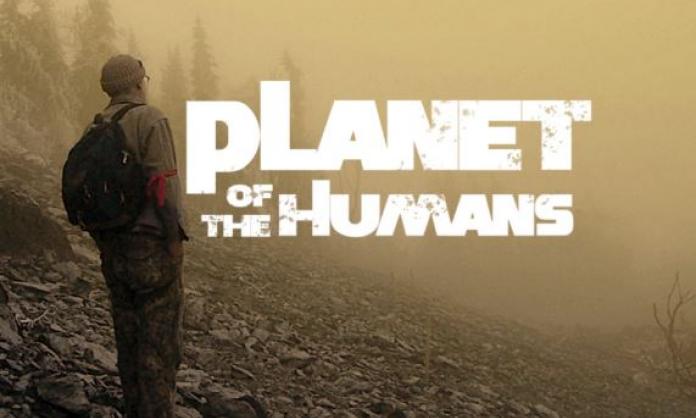Writer director Jeff Gibbs and executive producer Michael Moore’s latest release, Planet of the Humans, has many shortcomings, but its central argument is an important one: green capitalism is not very green and won’t save the planet.
The film has been criticised for taking aim at individuals and organisations within the environmental movement that have embraced, with varying degrees of enthusiasm, green technology as the solution to climate change. But the film is making a much broader point than that. It is above all an aggressive and much needed take down of the capitalist class’s strategy for defending the status quo in the face of mounting evidence of and concern over capitalism’s environmental destructiveness. For this it deserves credit.
Having had to abandon outright denialism, the international capitalist class is increasingly rallying around the idea that capitalism, through “green” innovation and technology, can meet the challenge of climate change without altering its market-dominated and profit-obsessed logic.
But, as Planet of the Humans points out, much “green” technology is still directly or indirectly dependent on fossil fuel-generated power, and some forms of it, in particular biomass, involve the direct destruction of forests to create energy.
The film also highlights that, even with the growth of these imperfect technologies, the rate at which they are displacing fossil fuel use is not nearly sufficient to head off climate catastrophe. Worse still, if they were to be expanded to meet the world’s current energy demands, the mining and extraction required would create a whole new environmental crisis.
Gibbs is not alone in making this argument. “[To] convert the US economy to zero emissions, renewable power by 2030, there will be a lot more ... mines gouged into the crust of the earth”, argued Jasper Bernes in a 2019 Commune article, “because nearly every renewable energy source depends upon non-renewable and frequently hard-to-access minerals: solar panels use indium, turbines use neodymium, batteries use lithium, and all require kilotons of steel, tin, silver, and copper. The renewable-energy supply chain is a complicated hopscotch around the periodic table and around the world”.
So while the efficiency of solar panels may be undersold in Planet of the Humans and the carbon footprint of “green” technology exaggerated, as many critics have pointed out, these inaccuracies do not invalidate the key contention. The fundamental problem remains: there is currently no environmentally sustainable way to maintain society’s current energy and fossil fuel use.
To the extent, then, that environmental concern is mitigated by the promise of green energy and the greenwashing of giant energy and resource companies, it is a major barrier to the collective recognition of the scale of the problem we are facing and to an understanding of the profound social change necessary to address it.
But being cognisant of the scale of the problem doesn’t automatically lead to the right solutions. The film’s creators have been rightly criticised for flagging population size and humans’ stubborn aversion to death as issues to be scrutinised in the quest for a sustainable society.
These arguments rest on the idea that consumption is a function of population, and therefore a society with fewer people would consume less. But as British environmentalist George Monbiot has pointed out in his critique of the film, consumption is growing at three times the rate of population. There are many reasons for this, but an important one is that a large proportion of energy consumption has nothing to do with population levels – it is done by industry and the state.
A 2019 report found that the US military, for example, uses more fossil fuels per year than most countries, “a situation it is locked into for years to come because of its dependence on existing aircraft and warships for open-ended operations around the globe”, according to Dr Patrick Bigger, one of the report’s co-authors.
And many environmentally inefficient processes persist because they minimise costs and maximise profits, not because population growth demands it. Plastic production is a good example – half of all the plastic in the world has been created since 2002, not because the world’s population has doubled, but because it is profitable. Forty percent of it goes into making disposable bottles and packaging, all things that we could do without but that boost sales and lower production costs.
Vast quantities of resources are wasted in capitalism to make us want things and to cajole or compel us to buy more, through intrusive advertising, built-in obsolescence and unnecessary packaging.
The filmmakers also identify the problems inherent to a profit-driven economy as a key obstacle to serious environmental action, which is valid. But the film leaves the viewer with a sense of helplessness at the momentous nature of the crisis facing the planet, reinforced at the end by some heartbreaking footage of an orangutan, whose habitat has been destroyed, struggling for life.
This is not a film that criticises green technology in order to give the fossil fuel industry licence to maintain business as usual. Instead, it is sounding the alarm against the powers that be and their collaborators that their efforts to greenwash capitalism will only further jeopardise the planet. No matter the spin, the status quo of capitalism simply cannot put the wellbeing of the natural world first.
The type of radical social change that is needed if we are to have any hope of establishing a genuinely sustainable society is not a topic broached by the film. It involves breaking out of the liberal mindset that dominates even the most critical environmental thinking. But without that change, it is difficult to see how the future is going to be anything other than increasing ecological chaos and the further disastrous degradation of human society.











